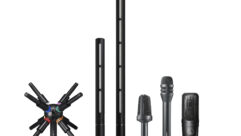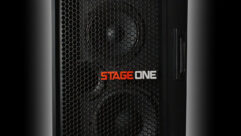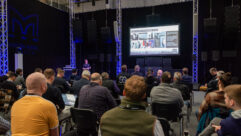
Technology Showcase: Fiber-Optic Audio Snakes
Jul 1, 2005 12:00 PM,
By Bruce Borgerson
Fiber-optic systems are a viable option for transporting AV content.
Fiber-optic audio snakes appeared with great fanfare in the late 1980s, carrying with them high hopes for quickly supplanting passive copper snakes across the full spectrum of applications. Alas, to the consternation of the companies involved, the anticipated revolution stalled out. Although fiber technology gradually managed to carve out a niche, starting with high-end mobile teleproduction, the sound-reinforcement and installation markets were slow to see the light.
After a slow start, fiber-optic audio snakes like Sundance Systems’ Fibox have gained popularity.
What took so long? Compared to a passive copper snake, the advantages of a digital fiber-optic system seem clear and — one would think — compelling. After all, those unwieldy reels of fat copper cables can pick up EMI/RFI interference, degrade the quality of low-level signals over distance, and develop ground loops at the most inopportune moments.
The nifty fiber-optic audio snake remedies all these ills by replacing weighty multicore cable with a thin strand of fiber-optic cable. Depending on the mode employed, this featherweight strand can carry dozens of audio channels for many miles with absolute freedom from signal degradation, ground loops, or electrical interference. What’s more, a thorough drenching doesn’t faze it in the least.
To the fiber-snake entrepreneurs of the late 1980s, quick market success seemed like a no-brainer. One industry insider, in fact, recalls three similar systems appearing at the 1989 AES convention, with at least one more hitting the market less than two years afterward. Initial interest was high, but excitement waned as key customers adopted a standoffish attitude: “Looks good, but let somebody else try it and let me know how it goes.” Consequently, within six years, all four budding systems had vanished from the marketplace.

Telecast Fiber Adder II
LESSONS LEARNED
Though these early systems were hailed for their advantages, they failed to flourish for reasons both obvious and subtle. The first and most obvious impediment was cost. On a channel-for-channel basis, the fiber-optic snake was roughly 10 times costlier than its copper counterpart, when considering a typical 300ft. application.
Another big hurdle was the shift of microphone pre-amplifier functions from FOH to the stage — unavoidable in an active digital system. This duplicated functions, rendering superfluous the pre-amplifiers in high-priced mixing consoles. It also inserted A/D and D/A conversion stages and required initial gain control adjustments to be made at the stage module. Not a popular move.
A third glitch was dynamic range. A passive snake may pick up noise, but handling peak signals is no problem. Early fiber-optic snakes (with 16- and 18-bit converters) could claim lower noise floors but needed more limiting help in handling peaks.
Finally, audio professionals were understandably concerned about the reliability of a technology that, though proven in military and commercial applications, was new to their realm of experience.
Fast-forward to 2005. Advancing technology has eliminated — in whole, or at least in large part — all downsides of the first-generation systems. For example, in live concert and performance systems, we have seen an increasing migration of remote-controlled pre-amps to the stage area, which makes a line-level fiber-optic snake more attractive in high-quality systems. Audio headroom and bandwidth are no longer worrisome, with most systems using 24-bit converters and many offering sampling rates up to 96kHz or even 192kHz. Component reliability has been proven in countless demanding applications, with remote broadcast a sterling example. Perhaps most importantly, costs have come down significantly as basic components, such as high-performance A/D and D/A converters, are now mass-manufactured.
Despite all the recent advances, pre-packaged, audio-only snake systems using fiber-optic transport as the exclusive mode remain relatively rare. In fact, only five are profiled in this showcase. That’s mainly because, for distances of less than 328ft., fiber now must compete with the new breed of Ethernet-based products.
This represents a major shift. When the first digital snakes appeared in 1989, the bandwidth required for realtime, multichannel audio was not available from a 10Base-T network. However, an exponential increase in network capacity has provided ample bandwidth, and at least four proprietary, audio-specific protocols have effectively dealt with signal latency. As a consequence, many new systems for transporting digital audio signals now rely on Cat-5 connections for short-haul jobs and resort to fiber-optic technology only when cable runs exceed the (more-or-less) 328ft. maximum range Ethernet can cover without repeaters.

Telecast Fiber Adder 162
A TECHNOLOGY CONTINUUM
The following survey of current fiber optic snakes will follow a continuum, starting with pure-and-simple packaged fiber optic audio systems and progressing through borderline engineered component systems. Although the latter group normally includes video and data signal as well, a few systems that can be configured for audio-only installed sound applications are profiled here. Not included are systems intended exclusively for broadcast applications. Finally, the fast-growing crop of Ethernet-based digital audio systems are given a brief overview because all can be piggybacked on fiber using media converters either supplied as factory options or purchased separately from third-party vendors.
FIBOX: BASIC AND MODULAR
The Fibox modules from Sundance Systems (Irving, Texas) can be configured to provide basic transmission systems with as few as two audio channels or as many as 12. Each master module includes two pre-amps for microphone or line-level inputs, phantom powering, input sensitivity control, and A/D converters (20-bit at 48kHz sampling). Outputs are on multimode fiber with conventional ST connectors. The lower-cost slave module has all the same input features, but signals are routed to the master via a multi-pin cable for multiplexing on the fiber link. Up to five slave units may be connected to each master.
The output-side master unit demuxes the signals, converts the two channels back to analog, and allows up to five more signal pairs via connected FBAO-S slave modules. Each module fits in 1/3RU, allowing a complete 12-channel transmit or receive system to fit in 2RU. The various modules range in price from $797 to $980.
For users who prefer to place digital audio on a fiber link, Sundance also offers the Fibox IMS transmission system. This expanded platform provides for 8 AES/EBU digital channels (16 audio channels) through a 1RU device at each end, with the price of the set given as $3,350. For analog input and output, users may connect up to six Fibox analog slave modules to the IMS for a mixture of analog and digital audio. An optional plug-in module slot accommodates the digital video transmission system. The standard multimode Fibox systems allow fiber-optic runs of up to 1.3 miles without repeaters. An optional single-mode master system ($3,191) allows runs of up to 30 miles.

NetworkSound Digital Snake
LIGHTVIPER: 21ST-CENTURY SNAKE
Although familiar to military and commercial users, Fiberplex (Annapolis Junction, Md.) is relatively new to the world of pro audio systems. The company is marketing its LightViper 1832 system as essentially a one-to-one replacement for the traditional multicore copper audio snake. The 1832 comprises a self-contained 32×8 system, with a stage box and an FOH rack unit linked by fiber. Each stage input has a Neutrik XLR combo mic/line connector, microphone pre-amp, phantom powering, and 24-bit/96kHz A/D converters. The eight return outputs are on XLR-M connectors. The stage unit also includes the fiber multiplexer/demultiplexers, BNC connectors for digital I/O word clock (master or slave), and an option for two additional fiber outputs for lossless digital splitting. The FOH module, housed in a 1RU cabinet, has five DB-25 connectors for the analog signals, plus three additional DB-25 connectors with AES/EBU inputs/outputs for connection to peripheral equipment for recording or broadcasting.
Including a 300ft. reel of multimode fiber and all breakout cables, the LightViper 1832 is priced at $8,646. The first optional fiber splitter is about $3,800; the second is around $3,400.
To accommodate a digital console scenario with mic pre-amps at the stage, LightViper offers the newer 4832 system. This system connects the console to multiple channels of existing mic pre-amps with digital outputs, providing transport for both the audio signals, and optionally, Ethernet and RS-422 control signals for remote control of pre-amps. A typical setup used in conjunction with Yamaha ADHR mic pre-amps, interfacing directly to a Yamaha PM5D or DM2000 console, is priced around $8,000, again with 300ft. of dual-core fiber included. A similar setup for the Ethernet-controlled systems (such as Aphex) requires four-core fiber and Ethernet modules, raising the cost to about $10,000. Other options accommodate a wide range of all-digital and hybrid configurations for both installed and touring sound systems.
Otari (Tokyo, Japan) targets the higher end of the audio-only market with its Lightwinder LW-55 systems. A fully loaded LW-55 system provides 64-channel, bi-directional capacity. Channels can be configured in groups of eight for microphone-level input, line-level input, or AES/EBU digital input and output. A/D conversion is 24-bit with sampling rates selectable from 44.1kHz to 96kHz. Dual transmission lines connect the units, each of which has a redundant power supply for fault-tolerant operation. Other features include an RS-422 interface for communication and machine control; provision for external word clocks at all sampling frequencies; and Windows-based software for status monitoring and control of signal routing, mic pre-amp gain, limiter functions, phantom power, and sampling rate conversion.

Otari LW-55
LIGHTWINDER: HIGH-END MODULAR
The base main station prices at $9,995, but once over that hump, the per-channel costs descend with larger configurations. Costs for the 8-channel modules are $1,635 for mic pre-amplifiers, $835 for A/D converters, $1,120 for D/A converters, and $975 for AES/EBU digital capability.
YAMAHA: PM COMPANION
To oblige the many thousands of PM1D users, Yamaha now offers the Artist 1D, a fiber snake designed specifically as a complement to the popular digital console. The Artist 1D, developed and manufactured by Reidel of Germany, is made up of a pair of rackmount units for connecting FOH and stage over distances of up to 1,640ft. with multimode fiber. The link handles up to 80 channels of bidirectional audio and also accommodates network connections for firmware updates, an SCSI bus for FOH inserts, and word clock I/O for master or slave mode. A host of redundancy and PM1D DSP-specific functions are included to seamlessly mate the transport protocols to the console. Each Artist 1D module costs $9,500, and Yamaha offers a complete tour package with dual modules, dual military-grade cables, adapter boxes, and all patch cables for $27,500.
OPTOCORE: GERMAN ENGINEERING
Optocore (Munich, Germany) makes a full line of fiber optic systems suitable for touring or installed sound applications. The LX4A (6U) functions as a 48×16 stage box with XLR connectors, but with the welcome addition of an input split on multipin connectors for recording. The companion LX4B (3U) has 48 outputs and 16 inputs on multipin connectors. Optocore’s DD32 (1RU) digital I/O unit is used with the X-6 series 16-channel analog converter units for building modular systems. All systems also offer USB, RS-232, RS-485, and video connectivity.
INTEGRATED AUDIO/VIDEO SYSTEMS
The next two manufacturers move beyond pre-packaged digital audio snakes into highly modular, integrated audio-video-data signal transport systems, with the bulk of sales going into the high-end teleproduction market. The more complex offerings from each require some degree of engineering sophistication to properly configure and use in field applications.
Communications Specialties (Hauppauge, N.Y.) offers a range of units in its Fiberlink series. The 32-channel (4320) and 16-channel (4160) audio systems, housed in 1RU rackmount cabinets, are unidirectional with 24-bit, 96 kHz resolution. The 4040 system provides four channels and is available either in a 6.6in.-wide 1RU cabinet or as a card for one slot of a 6000A card cage. The Fiber Flex system offers either four audio channels in one direction, or two bidirectional channels. Balanced or unbalanced audio connections are on installation-friendly Phoenix connectors.
Telecast Fiber Systems (Worcester, Mass.) staked out an early foothold in supplying combined audio/video fiber-optic snakes, sensing correctly that fiber technology might sell better to networks covering golf tournaments than it did to PA companies doing rock concerts. Consequently, Telecast’s Adder line has been a remote teleproduction staple for more than a decade, and the company aims to continue that tradition while broadening its market with its new Adder II line. The Adder II systems are built around the company’s proprietary Natrix bus architecture, with the core DSP engine allowing flexible reconfiguration of channels as needed from multiple in/out locations. Available input modules accommodate analog mic/line (24-bit A/D); AES/EBU digital; intercom (RTS, Clear-Com, 4W); serial data; GPI paths; and Ethernet. Up to 256 AES digital channels (512 audio channels) are accommodated on one fiber, with latency specified at less than 500 microseconds. For flexibility and redundancy, the main TX, RX, and AES patchbay modules offer multiple fiber and coaxial inputs and outputs. Although designed primarily for high-end teleproduction, the Adder II could find a good fit as part of installed systems in large performing arts or worship facilities that frequently double as TV production venues.
Finally, moving deeper into the realm of engineered components systems, Multidyne (Locust Valley, N.Y.) markets a full range of converters, transceivers, multiplexers, and other associated components for combined audio/video/data systems. Multidyne systems usually are custom-assembled from separate components, either as standalone modules or as cards for rackmount card trays, with many functions available. Most products are engineered as combined audio-video systems (audio and video cards can be mixed in the same tray, for example), although Multidyne does offer products exclusively for audio. Entry-level here is the 2-channel FTX/FRX system, offering 20-bit conversion, compatibility with AES/EBU and three other digital audio formats, and two data channels that can be reassigned as auxiliary audio channels. The DAM series offers modules for six channels of 24-bit audio plus three data channels in rackmountable (DAM-2000) or field-module (DAM-2200) configurations. The DAM-4000 boosts digital audio channel count to 40, with optional XLR interface panels for analog mic/line inputs.
List prices for the Telecast and Multidyne systems reflect the rigorous quality and flexibility demands of the companies’ core broadcast market. Modules are too numerous to specify here, and system prices vary widely depending on configurations. However, systems of six or more channels consistent with requirements at this level would start around $15,000 and go up from there.
HYBRIDS: NETWORK-TO-FIBER
The concluding five systems are not fiber-optic snakes in the strictest sense of the term, as all are designed primarily to function over Ethernet using standard Cat-5 cabling. However, they are included here briefly because each can be used to piggyback signals on fiber simply by adding media converters, either as a manufacturer option or purchased separately from third-party vendors.
As a rule, the copper-based Ethernet systems are limited to distances of 328ft. without repeaters, whereas most fiber-optic systems can carry signals for distances of a mile or more on relatively inexpensive multimode fiber. (Single-mode fiber can go for many miles but is much pricier.) Also, generally speaking, the “pure” fiber systems have lower latency, although new proprietary audio networking protocols have reduced latency to the 1ms range or below, making pure fiber systems effectively realtime in most live sound applications. Note that the proprietary audio networking protocols — at least five are on the market now — are not compatible with each other. Therefore, advance planning is crucial if system add-ons are contemplated for the future.
Peak Audio’s CobraNet was first out of the gate in the audio protocol race, claiming more than 40 licensees so far.
Whirlwind (Rochester, N.Y.) has jumped on board as well, with its family of E Snake systems. A number of options are offered for analog or digital inputs or outputs, with the original E Snake configured for 32×32 and the follow-up ES2 system providing 16 channels as either unidirectional or 8×8. The latest addition, the DCS88 transceiver, uses a low-power core allowing the unit to self-power through the Cat-5 cable — a significant benefit in many installed applications. All modules use 24-bit/48kHz converters, with up to 128 channels (64 bidirectional) on one system. Emerging Gigabit architecture will increase channel capacity tenfold. E Snake systems allow flexible switching and routing using Whirlwind’s own E Desk software.
NetworkSound (San Jose, Calif.) has entered the fray with another Ethernet-based system using the Media-accelerated Global Information Carrier (MaGIC) protocol from Gibson Labs. NetworkSound systems allow up to 32×32 configurations with support for 48kHz, 96kHz, and 192kHz sampling rates. The systems provide support for multiple audio formats, offer point-to-point or daisy-chain configuration options, and require no external control software. Modular architecture is upgradable in 8-channel blocks.
Aviom (West Chester, Pa.) is best known for its integrated mixing and monitoring systems based on networked audio, but the company also offers “open-ended” PRO snake systems that can connect with any analog devices at either end. The Aviom AN-16i (input) and AN-16o (output) modules allow system configuration in 16-channel blocks, with modules connected through the AN-16SB system bridge for up to 64 channels per Cat-5 cable. Audio networking is via Aviom’s proprietary A-Net protocol, which the company claims can function reliably at distances of up to 500ft., somewhat more than most other networked systems but far short of fiber-optic capability.
Devised and licensed by Digigram (Montbonnet, France), the EtherSound networked audio platform is gaining momentum, expanding from its European base into North America and Asia. NetCIRA from Fostex of Japan is a new EtherSound licensee for networked audio systems, offering a variety of compact modules for — as the name implies — networked commercial, industrial, and residential applications. The MS-8 module can be fitted as a master (transmitter) or slave (receiver), depending on application, with 8-channel cards available for AES/EBU digital audio or balanced/unbalanced analog. Other module options allow configurable GPIO (general-purpose input-output) and remote control of selected functions (mute, phantom power, gain) using the NetCIRA SET control software program. Aimed squarely at the contracting market, NetCIRA’s compact ES-Series comprises active and passive receiver modules for balanced and unbalanced line outputs, and even a module with a built-in 40W (mono)/20W (per-channel stereo) power amplifier for one-step connection of smaller loudspeakers to the network.
Finally, bringing us full circle is Klotz Digital AG (Munich, Germany), one of the four companies that introduced digital audio snakes back in 1969. The company’s pioneering Oaklink system is long gone, but Klotz remains active in digital audio networking with its broadcast-targeted Vadis digital audio and control network. The latest addition to the company’s integrated line, which includes consoles and the Varizone (also marketed by Atlas Sound) music/paging systems, is the Octo-Bus realtime audio network. Configured using 4-channel analog input and output boxes, with software-controlled remote gain at both ends, the system allows up to 16 units to be connected for 64-channel capability over Cat-5 cabling. The Vadis software allows independent remote assignment of any input to any output or any combination of channels.
With all the competition in networked systems, pricing on the lower end is quite reasonable, with module pairs for 8-channel systems selling for about $1,200 and roughly equivalent 16-channel systems going for less than $2,000. However, for systems with premium microphone pre-amplifiers and software-based control of switching/routing and remote pre-amplifier functions, pricing ascends to the $10,000-plus level for 32×32 systems.
Regardless of system size or expense, however, the leap to fiber is easy. For applications that need to go the distance, a few hundred dollars for a media converter turn the Cat-5 network system into a close cousin of the pure fiber-optic snake.
Expect to see more products of this type in the near future. Roland’s new Systems Solutions division, for example, has announced the introduction of new snake systems in 24×4 and 32×8 configurations. Set to ship in late 2005, the systems use the Roland Ethernet Audio Communication (REAC) protocol and offer a dedicated hardware remote controller — no computer required — for pre-amplifier gain and other functions.
Another maker of traditional audio snakes, Pro Co, will jump into the market with its three-module Cat-alyst system. Cat-alyst’s core network module allows the user to choose Pro Co’s own protocol or substitute a CobraNet card as needed for integration into larger, fully networked systems. Total audio capacity is 64 channels, and any input may be routed internally to any output. The separate input and output modules each accommodate eight analog channels, with the input modules offering VCA input-level control, pad, and phantom powering. Software control is via networked PC or wireless PDA. Module enclosure options include snake sub box, rack units, floor pockets, or wallmount.
For More Information
Aviom
www.aviom.com
Communications Specialties
www.commspecial.com
Fiberplex
http://lightviper.com
Klotz Digital
www.klotzdigital.com
Otari
www.otari.com
Multidyne
www.multidyne.com
NetCIRA by Fostex
www.netcira.com
NetworkSound
www.networksound.com
Optocore
www.optocore.de
Pro Co Sound
www.procosound.com
Roland Systems Solutions
www.rssamerica.com
Sundance Systems
www.lightwavesys.com
Telecast Fiber Systems
www.telecast-fiber.com
Whirlwind
www.whirlwindusa.com
Yamaha
www.yamaha.com/proaudio
Bruce Borgersonis principal of Wavelength Communications in Ashland, Ore.










